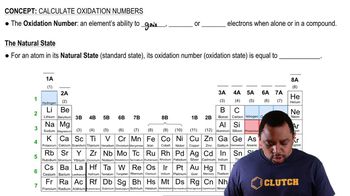Here are the essential concepts you must grasp in order to answer the question correctly.
Oxidation Numbers
Oxidation numbers are a way to keep track of electrons in chemical compounds, indicating the degree of oxidation of an atom. They are assigned based on a set of rules, such as the oxidation number of an element in its elemental form is zero, and the sum of oxidation numbers in a neutral compound is zero, while in a polyatomic ion, it equals the ion's charge.
Recommended video:
Rules for Assigning Oxidation Numbers
There are specific rules for assigning oxidation numbers, including that oxygen typically has an oxidation number of -2, hydrogen is +1 when bonded to non-metals, and halogens usually have an oxidation number of -1 unless they are bonded to oxygen or other halogens. These rules help in determining the oxidation states of elements in compounds.
Recommended video:
Polyatomic Ions
Polyatomic ions are charged species composed of two or more atoms covalently bonded, which together carry a net charge. In the case of the bromate ion (BrO-), understanding its structure and charge is essential for correctly assigning oxidation numbers to its constituent elements, in this case, bromine and oxygen.
Recommended video:
Polyatomic Ion Variations

 Verified step by step guidance
Verified step by step guidance


